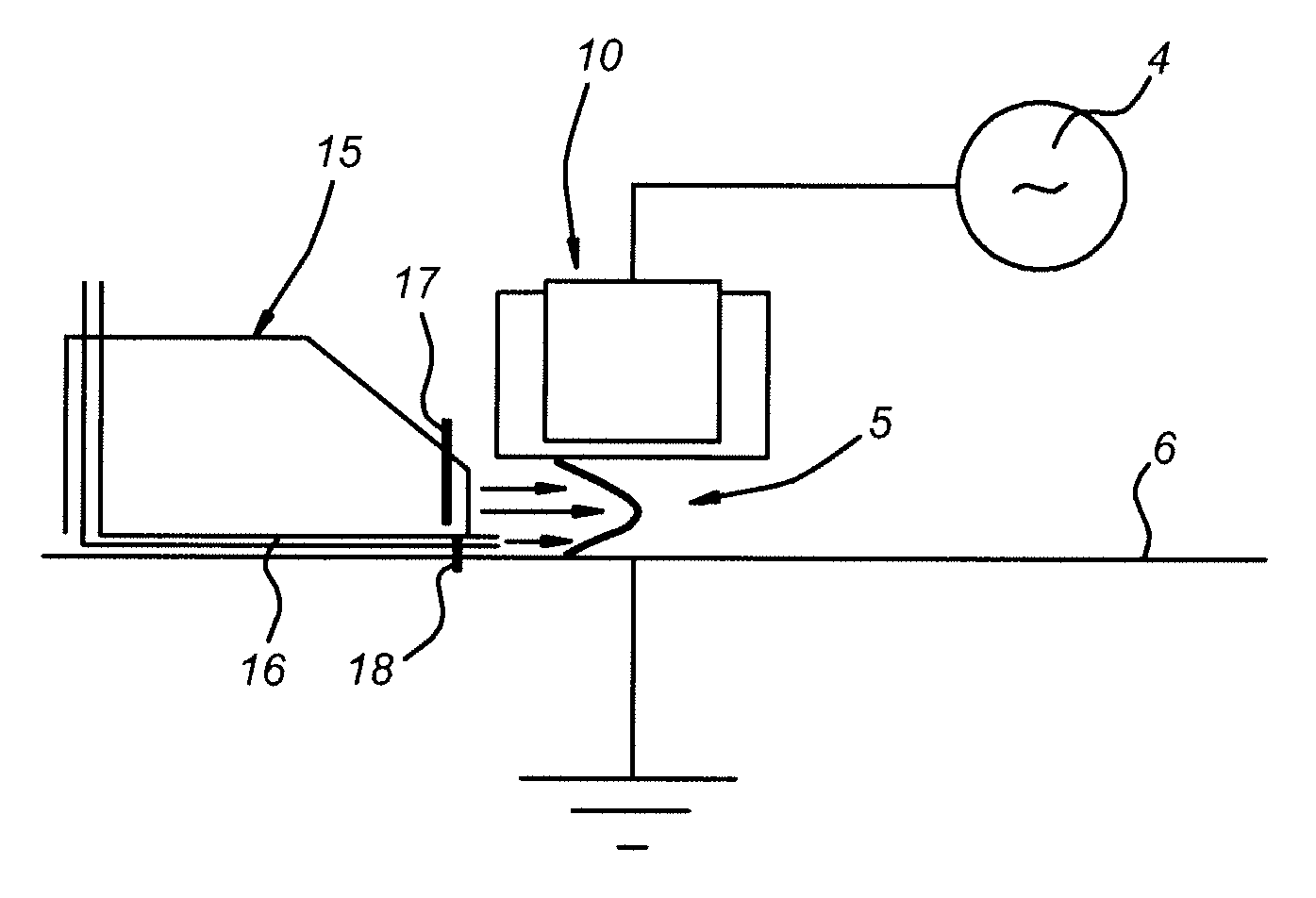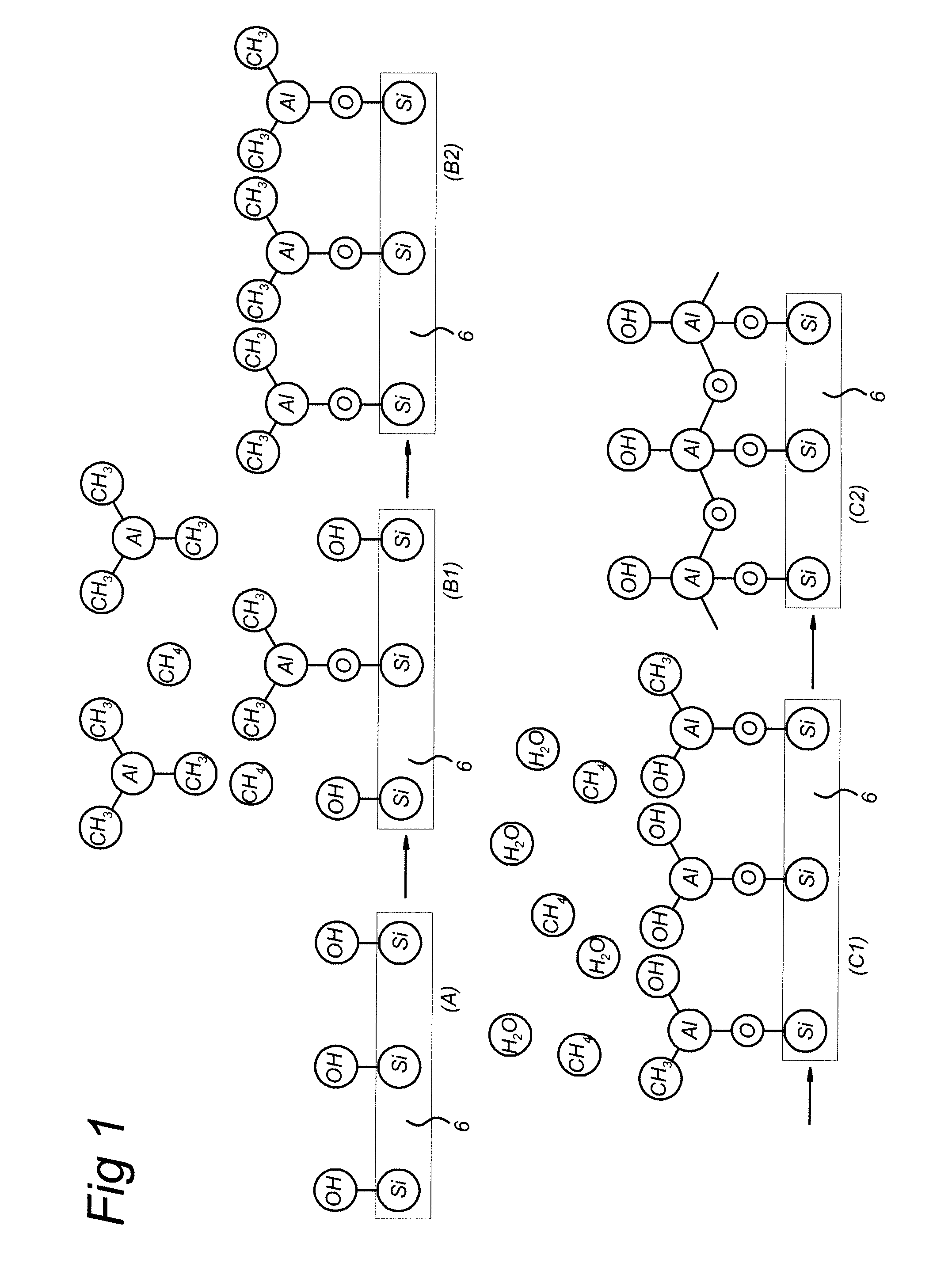Method and apparatus for atomic layer deposition using an atmospheric pressure glow discharge plasma
a glow discharge plasma and atomic layer technology, applied in the field of methods, can solve problems such as inability to deposition material on temperature sensitive substrates, and achieve the effect of higher reaction rates and higher productivity
- Summary
- Abstract
- Description
- Claims
- Application Information
AI Technical Summary
Benefits of technology
Problems solved by technology
Method used
Image
Examples
example 1
[0097]Step A: The polymer surface is made susceptible to the ALD reaction by a short CVD step in which a very thin film of SiO2 is deposited from TEOS (tetraethoxysilane) or HMDSO (hexamethyldisiloxane). The thin SiO2 surface is terminated via Si—OH groups, thus forming a surface layer comparable to the substrate 6 shown in FIG. 1 at reference (A).
[0098]Step B. In a first embodiment pulses of TMA precursor and oxygen gas are alternated while maintaining a purge step in between precursor and reactive agent to flush the electrode gap (above the surface of the substrate 6). The purge step may be performed using an inert gas, in this case Ar. This is shown schematically in the time plot of FIG. 2, which shows the respective gas flows and APG plasma pulse for a single cycle time period. Due to atmospheric pressure TMA is reacting very quickly with the hydroxyl groups. Typical concentration of TMA is 200 mg / hr.
[0099]Step C: After flushing the gap to remove the precursor the oxygen is inse...
example 2
[0102]In a further example, a continuous reactive (for instance 10% oxygen in argon) gas stream is used, during both step A and step B, while a pulsed TMA precursor treatment is used, as shown schematically in FIG. 3. During the entire cycle time of 0.8 sec, Argon and Oxygen are introduced in a continuous manner. The plasma conditions in this embodiment are the same as described with the previous embodiment.
treatmentOxygenGas compositiontimePlasma1) Argon + TMA1 slm10 slm + 200 mg / hr0.5off2) Argon1 slm10 slm0.2off3) Argon1 slm10 slm0.1on
example 3
[0103]In this example, also the input of TMA is in a continuous manner, and only the APG plasma is applied in a pulsed manner to enhance the ALD process, as shown in the time plot of FIG. 4. To reduce chemical vapor reaction the TMA flow should be limited to a region very nearby the surface 6 on which the Al2O3 has to be deposited. This embodiment allows for obtaining a very short cycle time of only 0.3 sec, as shown in the following table.
precursorOxygenGas + prectreatment timePlasma1) Argon200 mg / hr1 slm10 slm0.2off2) Argon200 mg / hr1 slm10 slm0.1on
[0104]The plasma conditions are again the same as in the previous two examples.
PUM
| Property | Measurement | Unit |
|---|---|---|
| thickness | aaaaa | aaaaa |
| temperature | aaaaa | aaaaa |
| pressure | aaaaa | aaaaa |
Abstract
Description
Claims
Application Information
 Login to View More
Login to View More - R&D
- Intellectual Property
- Life Sciences
- Materials
- Tech Scout
- Unparalleled Data Quality
- Higher Quality Content
- 60% Fewer Hallucinations
Browse by: Latest US Patents, China's latest patents, Technical Efficacy Thesaurus, Application Domain, Technology Topic, Popular Technical Reports.
© 2025 PatSnap. All rights reserved.Legal|Privacy policy|Modern Slavery Act Transparency Statement|Sitemap|About US| Contact US: help@patsnap.com



